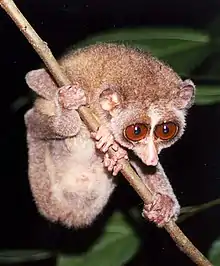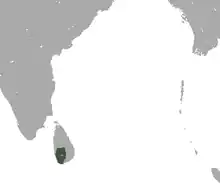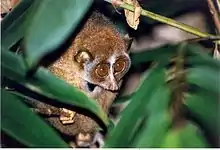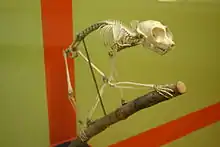Red slender loris
The red slender loris (Loris tardigradus) is a small, nocturnal strepsirrhine primate native to the rainforests of Sri Lanka. This is No. 6 of the 10 focal species and No. 22 of the 100 EDGE mammal species worldwide considered the most evolutionarily distinct and globally endangered.[4] Two subspecies have been identified, L. t. tardigradus and L. t. nycticeboides.[1]
| Red slender loris[1] | |
|---|---|
 | |
| Scientific classification | |
| Kingdom: | Animalia |
| Phylum: | Chordata |
| Class: | Mammalia |
| Order: | Primates |
| Suborder: | Strepsirrhini |
| Family: | Lorisidae |
| Genus: | Loris |
| Species: | L. tardigradus |
| Binomial name | |
| Loris tardigradus | |
| Subspecies | |
 | |
| Red slender loris range | |
| Synonyms | |
|
Lemur tardigradus Linnaeus, 1758 | |
Taxonomy
- Genus Loris
- Species Loris tardigradus – red slender loris
- L. tardigradus nycticeboides – Horton Plains slender loris (mountains Loris)
- L. tardigradus tardigradus – Dry Zone slender loris (lowland Loris)
- Species Loris lydekkerianus – gray slender loris
- Species Loris tardigradus – red slender loris
The ears are less prominent in L. tardigradus tardigradus compared to Loris lydekkerianus. The ears of L. tardigradus nycticeboides are almost invisible.
Description
This small, slender primate is distinguished by large forward-facing eyes used for precise depth perception, long slender limbs, a well-developed index finger, the absence of tail, and large prominent ears, which are thin, rounded and hairless at the edges. The soft dense fur is reddish-brown color on the back, and the underside is whitish-grey with a sprinkling of silver hair. Its body length on average is 7–10 in (180–250 mm), with an average weight of a mere 3–13 oz (85–369 g). This loris has a four-way grip on each foot. The big toe opposes the other 4 toes for a pincer-like grip on branches and food. It has a dark face mask with central pale stripe, much like the slow lorises.
L. tardigradus tardigradus is reddish brown in the back and creamy yellow below, while L. tardigradus nycticeboides is dark brown dorsally and very light brown in upperparts.
Behavior


The red slender loris favors lowland rainforests (up to 700 m in altitude), tropical rainforests and inter-monsoon forests of the south western wet-zone of Sri Lanka. Masmullah Proposed Forest Reserve harbors one of few remaining red slender loris populations, and is considered a biodiversity hotspot. The most common plant species eaten was Humboldtia laurifolia, occurring at 676 trees/ha, with overall density at 1077 trees/ha. Humboldtia laurifolia is vulnerable and has a mutualistic relationship with ants, providing abundant food for lorises.[5] Reports from the 1960s suggest that it once also occurred in the coastal zone, however it is now thought to be extinct there.
The red slender loris differ from its close relative the gray slender loris in its frequent use of rapid arboreal locomotion. It forms small social groups, containing adults of both sexes as well as young animals. This species is among the most social of the nocturnal primates. During daylight hours the animals sleep in groups in branch tangles, or curled up on a branch with their heads between their legs. The groups also undertake mutual grooming and play at wrestling. The adults typically hunt separately during the night. They are primarily insectivorous but also eat bird eggs, berries, leaves, buds and occasionally invertebrates as well as geckos and lizards. They forage, and while doing so, ants may stick to the back of their hands.[6] As this occurs, the red slender loris is able to consume these ants. To maximize protein and nutrient uptake they consume every part of their prey, including the scales and bones. They make nests out of leaves or find hollows of trees or a similar secure place to live in.
Reproduction

Females are dominant. The female reaches her sexual maturity at 10 months and is receptive to the male twice a year. This species mates while hanging upside down from branches; individuals in captivity will not breed if no suitable branch is available. The gestation period is 166–169 days after which the female will bear 1–2 young which feed from her for 6–7 months. The lifespan of this species is believed to be around 15–18 years in the wild.
Threats
This slender loris is an endangered species. Habitat destruction is a major threat. It is widely trapped and killed for use in supposed remedies for eye diseases and get killed by snakes, dogs, and some fish.[7] Other threats include: electrocution on live wires, road accidents and the pet trade.[8]
Conservation
The red slender loris was identified as one of the top-10 "focal species" in 2007 by the Evolutionarily Distinct and Globally Endangered (EDGE) project.[9]
One early success has been the rediscovery of the virtually unknown Horton Plains slender loris (Loris tardigradus nycticeboides). Originally documented in 1937, there have only been four known encounters in the past 72 years,[10] and for more than 60 years until 2002 the sub-species had been believed to be extinct.[11][12] The sub-species was rediscovered in 2002 by a team led by Anna Nekaris in Horton Plains National Park.[8] The late 2009 capture by a team working under the Zoological Society of London's EDGE programme has resulted in the first detailed physical examination of the Horton Plains sub-species and the first-ever photographs of it.[11] The limited available evidence suggests there may be only about 100 animals still existing, which would make it among the top five most-threatened primates worldwide.[12]
References
- Groves, C. P. (2005). Wilson, D. E.; Reeder, D. M. (eds.). Mammal Species of the World: A Taxonomic and Geographic Reference (3rd ed.). Baltimore: Johns Hopkins University Press. p. 122. ISBN 0-801-88221-4. OCLC 62265494.
- Nekaris, A. (2008). "Loris tardigradus". IUCN Red List of Threatened Species. 2008: e.T12375A3338689. doi:10.2305/IUCN.UK.2008.RLTS.T12375A3338689.en.
- Linnæus, Carl (1758). Systema naturæ per regna tria naturæ, secundum classes, ordines, genera, species, cum characteribus, differentiis, synonymis, locis. Tomus I (in Latin) (10th ed.). Holmiæ: Laurentius Salvius. p. 29. Retrieved 21 November 2012.
- "Slender loris". edgeofexistence.org. Archived from the original on 1 July 2007. Retrieved 13 August 2007.
- K. Anne-Isola Nekaris; Wasantha K. D. D. Liyanage; Saman N. Gamage (July 2005). "Influence of forest structure and composition on population density of the red slender loris Loris tardigradus tardigradus in Masmullah proposed forest reserve, Sri Lanka". Mammalia. 69 (2): 201–210. doi:10.1515/mamm.2005.017. S2CID 21708919.
- Kumara, H.N.; Kumar, Shanthala; Singh, Mewa. "A Novel Foraging Technique Observed in Slender Loris (Loris lydekkerianus malabaricus) Feeding on Red Ants in the Western Ghats, India". Karger. Retrieved 13 October 2020.
- Benders-Hyde, Elisabeth (2002). "Slender Loris". Retrieved 24 July 2007.
- Nekaris, K. A. I.; Jayewardene, J. (2004). "Survey of the slender loris (Primates, Lorisidae Gray, 1821: Loris tardigradus Linnaeus, 1758 and Loris lydekkerianus Cabrera, 1908) in Sri Lanka". Journal of Zoology. 262 (4): 327–338. doi:10.1017/S0952836903004710.
- "Protection for 'weirdest' species". BBC. 16 January 2007. Retrieved 22 May 2007.
- http://www.spiegel.de/wissenschaft/natur/0,1518,707502,00.html Der Spiegel (German) article about the rediscovery
- Krishan, Francis (19 July 2010). "Rare Sri Lankan primate gets 1st wide-eyed closeup". The Oregonian (from the Associated Press). Retrieved 23 July 2010.
- Smith, Lewis (19 July 2010). "Found: Sri Lankan primate thought to be extinct for 60 years". The Guardian. Retrieved 23 July 2010.
External links
| Wikimedia Commons has media related to Loris tardigradus. |
| Wikispecies has information related to Red Slender Loris. |
- ARKive – images and movies of the slender loris (Loris tardigradus and Loris lydekkerianus)
- EDGE of Existence "(Slender loris)" Saving the World's most Evolutionarily Distinct and Globally Endangered (EDGE) species
